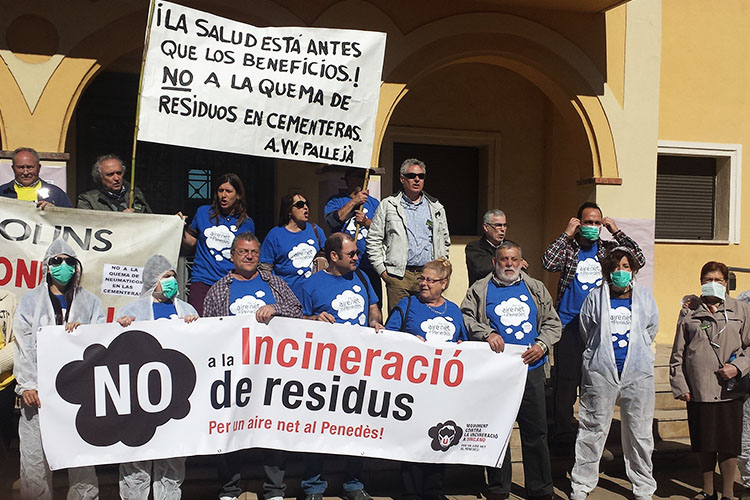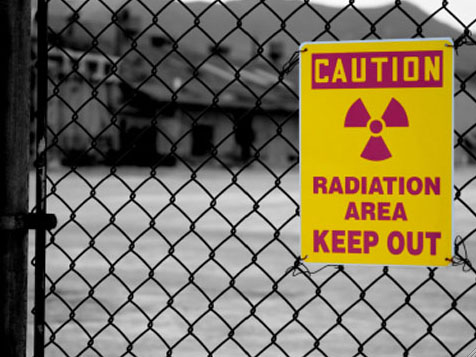Posts Tagged ‘Cancer’
Spanish Study: Link Between Cement Kilns and Cancer
 Although it was first published last July, news of a new Spanish epidemiological study of residents living in proximity to cement plants has just now reached us.
Although it was first published last July, news of a new Spanish epidemiological study of residents living in proximity to cement plants has just now reached us.
Done by the the same researchers responsible for a 2012 study that found statistically significant increases in all cancers around waste incineration and auto scrap metal operation, this more recent report focuses just on cement, lime and plaster plants.
According to the researchers, a statistically signifiant increase in all cancer mortality was detected in the vicinity of these installations as a whole, but principally, in the vicinity of cement installations. Specifically, tumors of the colon–rectum in both sexes and of the pleura peritoneum, gallbladder, bladder and stomach in men were noticably higher. In a summary of the results, the authors state they believe residents have "an excess risk of dying from cancer, especially in colon–rectum, in towns near these industries."
Because they take such a long time and so much effort, there's a dearth of epidemiological studies focused entirely on cancer risks among those living in proximity to cement plants, although a 2004 Italian study found a significantly greater risk of lung cancer among people living near a cement factory (whereas the results of another Italian study confirmed significant excesses for cancers like the nervous system, leukemia, mesothelioma and peritoneum in a region with the presence of various industries including cement factories.
In explaining the higher incidence of gut cancers among both men and women, the study hypothesizes about the possible ways local residents are exposed to carcinogens:
In our study, one aspect to be borne in mind is that colorectal
cancer is the only tumor with statistically significant excess risks
in men and women, which might be indicative of a pathway of
environmental exposure. In this case, two possible routes of exposure
to the pollution released by these installations are considered:
direct exposure to pollutants released to air; and indirect exposure,
both to pollutants and liquid effluents which are released to water
and can then pass into the soil and aquifers, and pollutants which
are released to air and then settle on plants. In such cases, the toxins
may pass into the trophic chain, affecting the population.Some authors have already shown associations between colorectal cancer and proximity to industrial pollution sources as metal industries (Garcia-Perez et al., 2010), mining (Fernandez-Navarro et al.,2012), food and beverage sector (Lopez-Abente et al., 2012) andchemical plants (Wilkinson et al., 1997). As regards cement plants,
a Brazilian study found a significant elevation on colorectal cancer
mortality in an industrialized area with cement industries came
into operation in the 1960s, among other facilities (Medrado-
Faria et al., 2001), and a Korean occupational study suggested a
potential association between exposure in the cement industry
and an increased risk of rectal cancer (Koh et al., 2013).
One thing a lot of these overseas studies and the Midlothian area have in common is a concentration of heavy industry. There's usually more than one facility and the region is considered an industrial corridor. That's certainly true of Midlothian, where besides hosting three large cement plants, the town is also home to a huge secondary steel mill, a power plant, and now an LNG plant. These industries combine to present a multitude of possible synergestic combinations of toxins to anyone living adjacent to, or downwind of them. "Toxic soup" is a term often used to describe the result.
This is also why the law lags behind the science in setting standards for cause and effect. When it's the cascade of chemicals from various facilities assaulting you, you're rarely going to be able to link a particular disease or illness with a specific plant. And yet the harm is happening all the same. This is why institutionalizing the "Precautionary Principle" into public policy is so important. It's much easier to prevent a chemical exposure than to track all of its ill effects after it's already doing damage.
“Statistically Significant Increase” in Risk of Dying from Cancer in Towns Near Incinerators
 You know that argument you sometimes hear about how those ecologically-minded Europeans are burning everything in incinerators and cement plants, so it must be OK to do it here? Maybe not so much.
You know that argument you sometimes hear about how those ecologically-minded Europeans are burning everything in incinerators and cement plants, so it must be OK to do it here? Maybe not so much.
In one of the most ambitious and far-ranging efforts of its kind ever attempted, the newly-published results of a 10-year study from Spain's national Center for Epidemiology looked for 33 different kinds of cancer in dozens of Spanish communities that hosted "waste incinerators and installations for the recovery or disposal of hazardous waste." They found "a significant higher risk from all cancers in towns near these industries."
Cancer impacts were greater around waste incinerators and scrap metal operations – you know like the three giant Midlothian cement plants upwind of DFW that are burning larger and larger amounts of industrial wastes and the steel mill across the street from them melting scrap cars.
Researchers used standard computer modeling to estimate what cancer rates should be in the host communities and then compared them to what they actually were.
"Excess cancer mortality was detected in the total population residing in the vicinity of these installations as a whole and, principally, in the vicinity of incinerators and scrap metal/end-of-life vehicle handling facilities, in particular. Special mention should be made of the results for tumors of the pleura, stomach, liver, kidney, ovary, lung, leukemia, colon–rectum, and bladder in the vicinity of all such installations. Our results support the hypothesis of a statistically significant increase in the risk of dying from cancer in towns near incinerators and installations for the recovery or disposal of hazardous waste."
There has never been any kind of systematic study of cancer rates around and downwind of the Midlothian cement plants. From the Texas birth defect registry we know that certain reproductive organ birth defects that are associated with pollutants known to have been released from the plants are higher than the state average in Ellis County.
This study, as well as the recent warnings of the federal Agency for Toxic Substances and Disease Registry about the public health dangers of the pollution coming from the Midlothian cement plants arrives at a time when the plants are gearing up to add plastics, car interiors, and other kinds of garbage to their lists of "fuels" that will be burned. After losing the fight to be able to burn hazardous wastes willy-nilly in cement plants, the industry is turning to industrial and municipal garbage that can produce many of the same worrisome kinds of pollution. This is what makes the EPA rules governing the emissions of the nation's cement plants – rules that are still in play – so very important.
Perry’s Politicizing of Science Costs Anti-Cancer Agency its Stars
 For most of modern history, Texas Governors haven't served more than two four-year terms and most had trouble doing that. Although they might be able to appoint a lot of folks to state agencies, current Governors couldn't re-make the agency into their own private fiefdom because there were too many members who owed their jobs to former Governors, maybe even ones from a different political party, or with different ideas about policy.
For most of modern history, Texas Governors haven't served more than two four-year terms and most had trouble doing that. Although they might be able to appoint a lot of folks to state agencies, current Governors couldn't re-make the agency into their own private fiefdom because there were too many members who owed their jobs to former Governors, maybe even ones from a different political party, or with different ideas about policy.
Rick Perry's never-ending-term has changed that. In office for 12 years and counting, he's managed to use time and the power of appointment to remake just about every executive branch agency the state has. And not just at the top, but deep, deep down into the upper and mid-level echelons of power. Because of the work we do, we see it most obviously with the Texas Commission on Environmental Quality, where Perry's influence reaches down to make sure the Chief Engineer is as ideologically-correct as the politically-appointed Chair. As a result, the Commission's science is harnessed in service to Rick Perry's perpetual campaign goals and is never allowed to contradict them.
But now that same MO seems to have backfired when it comes to superstar anti-cancer researchers who don't need the connections or positions Perry offered them.
Via the New York Times, (how come we haven't heard about this as much from Texas news outlets?) comes word that at least seven more scientists joined their former boss, a Nobel Prize winner, in walking out of Governor Perry's "Cancer Prevention and Research Institute." With $700 million in grant money, only the federal government offered more cash for research projects, so what could have forced such a walk-out?
Apparently, the researchers had the quaint idea that they'd actually be working on ways to, you know, cure cancer. Instead, Perry seems to have wanted the fund to provide another pipeline of money to his cronies in industry by focusing on "commercialization projects" that "focus on turning research into drugs or other products that can be sold rather than financing research itself."
Nobel laureate Dr. Alfred G Gilman resigned in protest last May after the Institute voted to approve such a $20 million dollar commercialization project. Now his colleagues are leaving in droves for the same reason.
"Phillip A. Sharp, another Nobel laureate, was among seven scientists who resigned last week, writing in his resignation letter that the agency’s decisions have carried a “suspicion of favoritism” in how the state is handing out taxpayer dollars.
Brian Dynlacht, another scientist who is leaving, warned that the agency was headed down a path of systematic abuses.
“You may find that it was not worth subverting the entire scientific enterprise — and my understanding was that the intended goal of C.P.R.I.T. was to fund the best cancer research in Texas — on account of this ostensibly new, politically driven, commercialization-based mission,” Dr. Dynlacht wrote in his letter."
Let's just be very clear about this. As long as Rick Perry is Governor, anyone who tells you a Texas state agency is an adequate watchdog for any industry, much less the state's polluters, either has no idea how state government works these days, or knows exactly how it works and is sending you down the proverbial garden path.
Authority Considers Large Epidemiological Study of Nuke Sites
 This is not your father's Nuclear Regulatory Commission.
This is not your father's Nuclear Regulatory Commission.
Spurred by recent studies in Germany and France that found children living near certain nuclear reactors were twice as likely to develop leukemia, NRC commissioners are considering undertaking one of the largest epidemiological studies ever considered, proposing to examine cancer rates of those living adjacent to or near all 104 American nukes.
According to the agency, about 1 million people live within five miles of operating nuclear plants, and more than 45 million live within 30 miles. The Comanche Peak nuclear power plant in Glen Rose is about 40 or so miles southwest of Ft. Worth. It actually sits partially in Hood County, which is north, or downwind, of the nuke most of the year. Hood County has seen its cancer rate "increase significantly" since the plant came online and posted a cancer mortality rate higher than more heavily-populated and polluted Tarrant County, according to one activist who looked at the state-collected data.
The challenges to doing this kind of unprecedented study well are vast. There are problems with population mobility, uncontrolled variables, and lack of appropriate data. Nevertheless, the NRC seems to be at least seriously considering the idea:
"The five-member NRC is expected to vote later this year on a proposal to investigate cancer rates in each census tract within a 30-mile radius of a nuclear reactor and assess cancers in children younger than 15 years old by reviewing their mothers' proximity to a nuclear facility during pregnancy. It would also review cases of leukemia, a cancer associated with radiation exposure of children."
